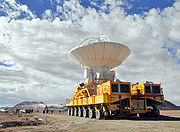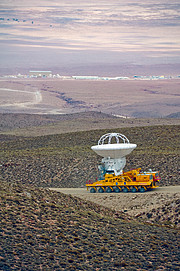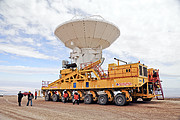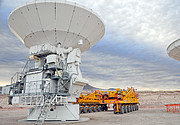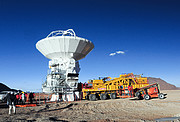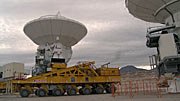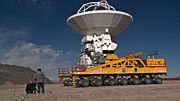Pressemitteilung
Erste ALMA-Antenne erreicht Beobachtungsstandort
23. September 2009
Mit dem Aufbau des Teleskopfeldes ALMA (Atacama Large Millimeter/submillimeter Array) geht es voran – und aufwärts. Zum ersten Mal wurde jetzt eine der neuartigen, extra für ALMA gebauten Antennen auf die Chajnantor-Hochebene in den chilenischen Anden transportiert, 5000 Meter über dem Meeresspiegel. Die Antenne, die rund 100 Tonnen wiegt und deren Schüssel einen Durchmesser von 12 Metern hat, wurde von einem Spezialtransporter an den für das ALMA-Antennenfeld vorgesehenen Standort transportiert, dessen Klima mit dünner und extrem trockener Luft ideale Beobachtungsbedingungen für das neuartige Observatorium bietet.
Die Bedingungen am ALMA-Beobachtungsstandort mögen ideal für die Astronomie sein – für die Wissenschaftler und Techniker stellen sie eine schwere Belastung dar. Der Sauerstoffgehalt der Luft ist nur halb so hoch wie auf Meereshöhe, und die Luft ist extrem trocken. Daher werden ALMAs Antennen im 2900 Meter über dem Meeresspiegel gelegenen “Basislager”, der ALMA Operations Support Facility (OSF, wörtlich die “Anlage für die Unterstützung des Betriebs von ALMA”), zusammengebaut und getestet. Von dort aus ist nun die erste ALMA-Antenne auf das Chajnantor-Plateau transportiert worden.
In den Worten von Wolfgang Wild, dem Projektleiter des europäischen Teils des ALMA-Konsortiums: “Dies ist ein wichtiger Augenblick für ALMA. Wir sind sehr froh, dass der erste Antennentransport auf die Hochebene so reibungslos verlaufen ist. Dass wir nun eine erste ALMA-Antenne auf dem Hochplateau haben, ist nur durch die Beiträge aller Partner möglich geworden: Diese spezielle Antenne wurde in Japan hergestellt, der Spezialtransporter in Europa, und die Empfangselektronik der Antenne in Nordamerika, Europa und Asien.”
Zu Beginn der Reise hob Otto, einer der zwei ALMA-Transporter, die Antenne auf seine Ladefläche. Dann begann die Fahrt entlang der 28 Kilometer langen Strecke von der Operations Support Facility zum Beobachtungsstandort. Obwohl die Transporter im belandenen Zustand Geschwindigkeiten bis zu 12 Kilometer pro Stunde erreichen können, war für diese erste Fahrt bewusst eine niedrigere Geschwindigkeit gewählt worden. So konnte laufend überprüft werden, dass der Transport tatsächlich genau so verlief wie vorgesehen. Die Fahrzeit betrug insgesamt rund sieben Stunden.
Die ALMA-Antennen sind die fortschrittlichsten Antennen ihrer Art – Antennen zum Empfang von
elektromagnetischer Strahlung mit Wellenlängen im Submillimeterbereich –, die je gebaut wurden. Sie sind so ausgelegt, dass sie den harschen Umweltbedingungen am Beobachtungsstandort gewachsen sind: Die Antennen müssen starke Winde sowie Temperaturen zwischen +20 und -20 Grad Celsius aushalten, und dabei noch höchsten Anforderungen genügen: Zum einen müssen die Antennen jederzeit exakt ausgerichtet werden können – ihr Blickfeld am Himmel hat die gleiche scheinbare Größe wie ein Golfball in 15 Kilometer Entfernung. Zum anderen müssen die Reflexionsflächen der Schüssel auf weniger als 25 Mikrometer – das ist weniger als der Durchmesser eines menschlichen Haares – genau geformt sein, und diese Form auch beibehalten.
Thijs de Graauw, Direktor von ALMA: “Der Transport unserer ersten Antenne auf das Chajnantor-Plateau ist eine beachtliche Leistung. Für das ALMA-Projekt ist dies eine äußerst spannende Phase. Dank unserer weltweiten Kooperationspartner kommen wir der Vollendung des ehrgeizigsten bodengebundenen astronomischen Observatoriums Schritt für Schritt näher.”
Auf dem Hochplateau angekommen, hat der Transporter die Antenne millimetergenau auf einem Betonfundament abgesetzt, das Anschlüsse für Elektrizität und Datenübertragung bietet. Der Transporter wird bei solchen Operationen durch ein Laserleitsystem punktgenau an den richtigen Ort manövriert. Zusätzlich ist der Transporter, ähnlich heutigen Personenwagen gehobener Klasse, mit einem Ultraschall-Anti-Kollisionssystem ausgestattet, damit er auf seiner Fahrt keine der letztendlich 66 Antennen gefährdet, die auf dem Chajnantor-Plateau ihren Standort – je eines von 200 Fundamenten – finden sollen. Diese Antennen werden zu einem einzigen, gigantischen Teleskop zusammengeschaltet, dessen äußerste Antennen bis zu 18,5 Kilometer voneinander entfernt sein können. Mit Hilfe der Transporter kann die Antennenformation verändert werden, je nach den Erfordernissen der aktuellen Beobachtungen.
Die erste ALMA-Antenne wird nicht lange allein bleiben. Bereits 2010 sollen drei ALMA-Antennen auf dem Hochplateau zusammengeschaltet werden, und ab dem zweiten Halbjahr 2011 sollen die ersten wissenschaftlichen Beobachtungen erfolgen.
Mit ALMAs Hilfe wollen die Astronomen wichtige Fragen nach unseren kosmischen Ursprüngen angehen. ALMA wird das Universum im Wellenlängenbereich von Millimeter- und Submillimeterwellen beobachten. Bei diesen Wellenlängen strahlen einige der kältesten, aber auch einige der am weitesten entfernten Objekte im Kosmos – kalte Gas- und Staubwolken, in denen Sterne geboren werden, und ferne Galaxien am Rande des beobachtbaren Universum. Darüber, wie sich das Universum in diesem Wellenlängenbereich darbietet, ist bislang vergleichsweise wenig bekannt, da solche Beobachtungen fortschrittlichste Detektortechnologie und zudem extrem trockenes Klima – wie es auf dem Chajnantor gegeben ist – voraussetzen.Weitere Informationen
Das Atacama Large Millimeter/submillimeter Array (ALMA, wörtlich: “Das große Millimeter-/Submillimeter-[Antennen]feld in [der Wüste] Atacama”) ist ein internationales astronomisches Observatorium. Die Partner, die das Antennenfeld betreiben, sind Europa, Nordamerika, und Ostasien, in Zusammenarbeit mit der Republik Chile. ESO ist der europäische ALMA-Partner. ALMA ist das derzeit größte astronomische Projekt. ALMAs Antennenfeld soll aus 66 riesigen Antennen, einige davon mit 12 Metern, andere mit 7 Metern Schüsseldurchmesser bestehen, die elektromagnetische Strahlung mit Millimeter- und Submillimeter-Wellenlängen auffangen. ALMA soll 2011 den wissenschaftlichen Beobachtungsbetrieb aufnehmen.
Die Europäische Südsternwarte ESO (European Southern Observatory) ist die führende europäische Organisation für astronomische Forschung und das wissenschaftlich produktivste Observatorium der Welt. Getragen wird die Organisation durch ihre 14 Mitgliedsländer: Belgien, Dänemark, Deutschland, Finnland, Frankreich, Italien, die Niederlande, Österreich, Portugal, Spanien, Schweden, die Schweiz, die Tschechische Republik und das Vereinigte Königreich. Die ESO ermöglicht astronomische Spitzenforschung, indem sie leistungsfähige bodengebundene Teleskope entwirft, konstruiert und betreibt. Auch bei der Förderung internationaler Zusammenarbeit auf dem Gebiet der Astronomie spielt die Organisation eine maßgebliche Rolle. Die ESO betreibt drei weltweit einzigartige Beobachtungsstandorte in Nordchile: La Silla, Paranal und Chajnantor. Auf Paranal betreibt die ESO mit dem Very Large Telescope (VLT) das weltweit leistungsfähigste Observatorium für Beobachtungen im Bereich des sichtbaren Lichts. Die ESO ist der europäische Partner für den Aufbau des Antennenfelds ALMA, des größten astronomischen Projekts überhaupt. Derzeit entwickelt die ESO das European Extremely Large Telescope (E-ELT) für Beobachtungen im Bereich des sichtbaren und Infrarotlichts, mit 42 Metern Spiegeldurchmesser ein Großteleskop der Extraklasse.Links
- Weitere Informationen über ALMA (in englischer Sprache):
http://www.almaobservatory.org/
Kontaktinformationen
Wolfgang Wild
ESO
Garching, Germany
Tel: +49 89 3200 6716
E-Mail: wwild@eso.org
Douglas Pierce-Price
ESO
Garching, Germany
Tel: +49 89 3200 6759
E-Mail: dpiercep@eso.org
Peter Habison (Pressekontakt Österreich)
ESO Science Outreach Network
und stem & mint e.U. – Space and Science Communications
Vienna, Austria
Tel: +43 676 648 7003
E-Mail: eson-austria@eso.org
Über die Pressemitteilung
| Pressemitteilung Nr.: | eso0935de-at |
| Legacy ID: | PR 35/09 |
| Name: | Atacama Large Millimeter/submillimeter Array |
| Typ: | Unspecified : Technology : Observatory : Telescope |
| Facility: | Atacama Large Millimeter/submillimeter Array |
Our use of Cookies
We use cookies that are essential for accessing our websites and using our services. We also use cookies to analyse, measure and improve our websites’ performance, to enable content sharing via social media and to display media content hosted on third-party platforms.
ESO Cookies Policy
The European Organisation for Astronomical Research in the Southern Hemisphere (ESO) is the pre-eminent intergovernmental science and technology organisation in astronomy. It carries out an ambitious programme focused on the design, construction and operation of powerful ground-based observing facilities for astronomy.
This Cookies Policy is intended to provide clarity by outlining the cookies used on the ESO public websites, their functions, the options you have for controlling them, and the ways you can contact us for additional details.
What are cookies?
Cookies are small pieces of data stored on your device by websites you visit. They serve various purposes, such as remembering login credentials and preferences and enhance your browsing experience.
Categories of cookies we use
Essential cookies (always active): These cookies are strictly necessary for the proper functioning of our website. Without these cookies, the website cannot operate correctly, and certain services, such as logging in or accessing secure areas, may not be available; because they are essential for the website’s operation, they cannot be disabled.
Functional Cookies: These cookies enhance your browsing experience by enabling additional features and personalization, such as remembering your preferences and settings. While not strictly necessary for the website to function, they improve usability and convenience; these cookies are only placed if you provide your consent.
Analytics cookies: These cookies collect information about how visitors interact with our website, such as which pages are visited most often and how users navigate the site. This data helps us improve website performance, optimize content, and enhance the user experience; these cookies are only placed if you provide your consent. We use the following analytics cookies.
Matomo Cookies:
This website uses Matomo (formerly Piwik), an open source software which enables the statistical analysis of website visits. Matomo uses cookies (text files) which are saved on your computer and which allow us to analyze how you use our website. The website user information generated by the cookies will only be saved on the servers of our IT Department. We use this information to analyze www.eso.org visits and to prepare reports on website activities. These data will not be disclosed to third parties.
On behalf of ESO, Matomo will use this information for the purpose of evaluating your use of the website, compiling reports on website activity and providing other services relating to website activity and internet usage.
Matomo cookies settings:
Additional Third-party cookies on ESO websites: some of our pages display content from external providers, e.g. YouTube.
Such third-party services are outside of ESO control and may, at any time, change their terms of service, use of cookies, etc.
YouTube: Some videos on the ESO website are embedded from ESO’s official YouTube channel. We have enabled YouTube’s privacy-enhanced mode, meaning that no cookies are set unless the user actively clicks on the video to play it. Additionally, in this mode, YouTube does not store any personally identifiable cookie data for embedded video playbacks. For more details, please refer to YouTube’s embedding videos information page.
Cookies can also be classified based on the following elements.
Regarding the domain, there are:
- First-party cookies, set by the website you are currently visiting. They are stored by the same domain that you are browsing and are used to enhance your experience on that site;
- Third-party cookies, set by a domain other than the one you are currently visiting.
As for their duration, cookies can be:
- Browser-session cookies, which are deleted when the user closes the browser;
- Stored cookies, which stay on the user's device for a predetermined period of time.
How to manage cookies
Cookie settings: You can modify your cookie choices for the ESO webpages at any time by clicking on the link Cookie settings at the bottom of any page.
In your browser: If you wish to delete cookies or instruct your browser to delete or block cookies by default, please visit the help pages of your browser:
Please be aware that if you delete or decline cookies, certain functionalities of our website may be not be available and your browsing experience may be affected.
You can set most browsers to prevent any cookies being placed on your device, but you may then have to manually adjust some preferences every time you visit a site/page. And some services and functionalities may not work properly at all (e.g. profile logging-in, shop check out).
Updates to the ESO Cookies Policy
The ESO Cookies Policy may be subject to future updates, which will be made available on this page.
Additional information
For any queries related to cookies, please contact: pdprATesoDOTorg.
As ESO public webpages are managed by our Department of Communication, your questions will be dealt with the support of the said Department.

